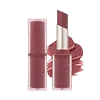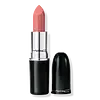What's inside
What's inside
 Key Ingredients
Key Ingredients

 Benefits
Benefits

 Concerns
Concerns

 Ingredients Side-by-side
Ingredients Side-by-side

Dimethicone
EmollientDibutyl Adipate
EmollientHydrogenated Polyisobutene
EmollientSynthetic Beeswax
Emulsion StabilisingVinyl Dimethicone/Methicone Silsesquioxane Crosspolymer
Diisopropyl Dimer Dilinoleate
EmollientPolymethylsilsesquioxane
Polyglyceryl-2 Triisostearate
EmulsifyingCI 77891
Cosmetic ColorantDimethicone Crosspolymer
Emulsion StabilisingCI 77491
Cosmetic ColorantSilica
AbrasiveCaprylic/Capric Triglyceride
MaskingCopernicia Cerifera Wax
Rubus Occidentalis Seed Oil
EmollientSimmondsia Chinensis Seed Oil
EmollientCaprylic/Capric/Myristic/Stearic Triglyceride
EmollientDicalcium Phosphate
AbrasiveSorbitan Isostearate
EmulsifyingDiphenylsiloxy Phenyl Trimethicone
Skin ConditioningEuphorbia Cerifera Wax
Phytosteryl/Octyldodecyl Lauroyl Glutamate
Skin ConditioningPolyglyceryl-2 Diisostearate
EmulsifyingDimethicone/Vinyl Dimethicone Crosspolymer
Skin ConditioningStearalkonium Hectorite
Gel FormingSilica Dimethyl Silylate
EmollientSucrose Tetrastearate Triacetate
EmollientPropylene Carbonate
SolventTocopherol
AntioxidantParfum
MaskingCI 15850
Cosmetic ColorantCI 42090
Cosmetic ColorantCI 77499
Cosmetic ColorantMica
Cosmetic ColorantCI 15985
Cosmetic ColorantCI 17200
Cosmetic ColorantCI 77492
Cosmetic ColorantTriethoxycaprylylsilane
Dimethicone, Dibutyl Adipate, Hydrogenated Polyisobutene, Synthetic Beeswax, Vinyl Dimethicone/Methicone Silsesquioxane Crosspolymer, Diisopropyl Dimer Dilinoleate, Polymethylsilsesquioxane, Polyglyceryl-2 Triisostearate, CI 77891, Dimethicone Crosspolymer, CI 77491, Silica, Caprylic/Capric Triglyceride, Copernicia Cerifera Wax, Rubus Occidentalis Seed Oil, Simmondsia Chinensis Seed Oil, Caprylic/Capric/Myristic/Stearic Triglyceride, Dicalcium Phosphate, Sorbitan Isostearate, Diphenylsiloxy Phenyl Trimethicone, Euphorbia Cerifera Wax, Phytosteryl/Octyldodecyl Lauroyl Glutamate, Polyglyceryl-2 Diisostearate, Dimethicone/Vinyl Dimethicone Crosspolymer, Stearalkonium Hectorite, Silica Dimethyl Silylate, Sucrose Tetrastearate Triacetate, Propylene Carbonate, Tocopherol, Parfum, CI 15850, CI 42090, CI 77499, Mica, CI 15985, CI 17200, CI 77492, Triethoxycaprylylsilane
Diisostearyl Malate
EmollientCaprylic/Capric Triglyceride
MaskingRicinus Communis Seed Oil
MaskingHydrogenated Polydecene
EmollientBis-Diglyceryl Polyacyladipate-2
EmollientPolyethylene
AbrasiveTrioctyldodecyl Citrate
EmollientPolybutene
Silica
AbrasiveOzokerite
Emulsion StabilisingEuphorbia Cerifera Wax
Octyldodecanol
EmollientCalcium Aluminum Borosilicate
Tocopheryl Acetate
AntioxidantSodium Hyaluronate
HumectantSqualane
EmollientButyrospermum Parkii Butter
Skin ConditioningCocos Nucifera Oil
MaskingGlycine Soja Seed Extract
Skin ConditioningHordeum Vulgare Extract
EmollientOlea Europaea Fruit Oil
MaskingRubus Idaeus Seed Oil
EmollientSimmondsia Chinensis Seed Oil
EmollientTriticum Vulgare Germ Extract
Skin ConditioningC12-15 Alkyl Benzoate
AntimicrobialCeramide Ng
Skin ConditioningTribehenin
EmollientPalmitoyl Hexapeptide-12
Skin ConditioningTitanium/Titanium Dioxide
Cosmetic ColorantAlumina
AbrasiveSynthetic Fluorphlogopite
Aluminum Calcium Sodium Silicate
Calcium Sodium Borosilicate
Tin Oxide
AbrasivePEG-10 Phytosterol
EmulsifyingLinoleic Acid
CleansingEthylhexyl Hydroxystearate
EmollientPhytosteryl Isostearate
Skin ConditioningHydrogenated Castor Oil
EmollientVanillin
MaskingTetrahexyldecyl Ascorbate
AntioxidantPhenoxyethanol
PreservativeMica
Cosmetic ColorantCI 77891
Cosmetic ColorantCI 77491
Cosmetic ColorantCI 77492
Cosmetic ColorantCI 77499
Cosmetic ColorantCI 77163
Cosmetic ColorantCI 77400
Cosmetic ColorantCI 42090
Cosmetic ColorantCI 75470
Cosmetic ColorantCI 15850
Cosmetic ColorantCI 45380
Cosmetic ColorantCI 45410
Cosmetic ColorantCI 73360
Cosmetic ColorantCI 17200
Cosmetic ColorantCI 19140
Cosmetic ColorantCI 15985
Cosmetic ColorantDiisostearyl Malate, Caprylic/Capric Triglyceride, Ricinus Communis Seed Oil, Hydrogenated Polydecene, Bis-Diglyceryl Polyacyladipate-2, Polyethylene, Trioctyldodecyl Citrate, Polybutene, Silica, Ozokerite, Euphorbia Cerifera Wax, Octyldodecanol, Calcium Aluminum Borosilicate, Tocopheryl Acetate, Sodium Hyaluronate, Squalane, Butyrospermum Parkii Butter, Cocos Nucifera Oil, Glycine Soja Seed Extract, Hordeum Vulgare Extract, Olea Europaea Fruit Oil, Rubus Idaeus Seed Oil, Simmondsia Chinensis Seed Oil, Triticum Vulgare Germ Extract, C12-15 Alkyl Benzoate, Ceramide Ng, Tribehenin, Palmitoyl Hexapeptide-12, Titanium/Titanium Dioxide, Alumina, Synthetic Fluorphlogopite, Aluminum Calcium Sodium Silicate, Calcium Sodium Borosilicate, Tin Oxide, PEG-10 Phytosterol, Linoleic Acid, Ethylhexyl Hydroxystearate, Phytosteryl Isostearate, Hydrogenated Castor Oil, Vanillin, Tetrahexyldecyl Ascorbate, Phenoxyethanol, Mica, CI 77891, CI 77491, CI 77492, CI 77499, CI 77163, CI 77400, CI 42090, CI 75470, CI 15850, CI 45380, CI 45410, CI 73360, CI 17200, CI 19140, CI 15985
 Reviews
Reviews

Ingredients Explained
These ingredients are found in both products.
Ingredients higher up in an ingredient list are typically present in a larger amount.
This ingredient is an emollient, solvent, and texture enhancer. It is considered a skin-softener by helping the skin prevent moisture loss.
It helps thicken a product's formula and makes it easier to spread by dissolving clumping compounds.
Caprylic Triglyceride is made by combining glycerin with coconut oil, forming a clear liquid.
While there is an assumption Caprylic Triglyceride can clog pores due to it being derived from coconut oil, there is no research supporting this.
Learn more about Caprylic/Capric TriglycerideCi 15850 is the pigment color red. It is an azo dye and created synthetically.
Azo dyes need to be thoroughly purified before use. This allows them to be more stable and longer-lasting.
This ingredient is common in foundations, lipsticks, and blushes. This color is described as brown/orangey red.
It has many secondary names such as Red 6 and Red 7. According to a manufacturer, Red 6 usually contains aluminum.
Learn more about CI 15850Ci 15985 is a dye made from petroleum. It is synthetically created and approved by the FDA for use in foods and cosmetics.
The color of this dye is orange/yellow.
This ingredient can be found in makeup, sun care, and skincare.
Learn more about CI 15985Ci 17200 is a synthetic reddish-purple dye.
Ci 42090 is a synthetic dye created from petroleum. It is used to give a bright blue color to cosmetics, medicine, and food.
Ci 77491 is also hydrated iron III oxide. It's sole purpose is to give a red/pink hue to products.
Iron III oxides are classified as inorganic chemicals for coloring.
Synthetically created Ci 77491 is considered safer than those naturally found. This is because the synthetically created version may contain less impurities. Iron oxides are generally non-toxic and non-allergenic.
Learn more about CI 77491Ci 77492 is also hydrated iron III oxide. It's sole purpose is to give a yellow hue to products.
Iron III oxides are classified as inorganic chemicals for coloring.
Synthetically created Ci 77492 is considered safer than those naturally found. This is because the synthetically created version may contain less impurities. Iron oxides are generally non-toxic and non-allergenic.
Learn more about CI 77492Ci 77499 is also hydrated iron III oxide. It is created from mixing red and black iron oxides. This helps give shades of darkness to a product.
Iron III oxides are classified as inorganic chemicals for coloring.
Ci 77891 is a white pigment from Titanium dioxide. It is naturally found in minerals such as rutile and ilmenite.
It's main function is to add a white color to cosmetics. It can also be mixed with other colors to create different shades.
Ci 77891 is commonly found in sunscreens due to its ability to block UV rays.
Learn more about CI 77891Mica is a naturally occurring mineral used to add shimmer and color in cosmetics. It can also help improve the texture of a product or give it an opaque, white/silver color.
Serecite is the name for very fine but ragged grains of mica.
This ingredient is often coated with metal oxides like titanium dioxide. Trace amounts of heavy metals may be found in mica, but these metals are not harmful in our personal products.
Mica has been used since prehistoric times throughout the world. Ancient Egyptian, Indian, Greek, Roman, Aztec, and Chinese civilizations have used mica.
Learn more about MicaSilica, also known as silicon dioxide, is a naturally occurring mineral. It is used as a fine, spherical, and porous powder in cosmetics.
Though it has exfoliant properties, the function of silica varies depending on the product.
The unique structure of silica enhances the spreadability and adds smoothness, making it a great texture enhancer.
It is also used as an active carrier, emulsifier, and mattifier due to its ability to absorb excess oil.
In some products, tiny microneedles called spicules are made from silica or hydrolyzed sponge. When you rub them in, they lightly polish away dead skin layers and enhance the penetration of active ingredients.
Learn more about SilicaThis oil comes from the seeds of the desert shrub called Jojoba. It is more commonly known as jojoba oil, a non-comedogenic oil.
Jojoba oil does not contain fragrance and has many fatty-acids, making it a great soothing ingredient.
It also contains Vitamin E, a great moisturizing ingredient. Vitamin E is also an antioxidant and protects your skin against oxidative damage.
This ingredient humectant properties, meaning it helps draw moisture from the air. This helps keep your skin hydrated.
While jojoba has antibacterial properties, it is only able to kill some strains of bacteria.
Studies also show it helps in wound healing. In fact, Indigenous cultures have used jojoba as a moisturizer and to help treat burns for centuries.
Fun fact: Jojoba oil similar to natural human skin sebum, so it has a great effect on dry skin. It is also promising with helping to regulate sebum production.
Due to its fatty acid content, Jojoba oil may not be fungal acne safe. We recommend speaking with a professional if you have any concerns.
Learn more about Simmondsia Chinensis Seed OilEuphorbia Cerifera wax comes from a shrub in Northern Mexico. It is used to stabilize formulations and has emollient properties.
Emollients form a thin layer on top of skin to prevent water from evaporating, keeping skin and lips hydrated.
According to a manufacturer, this wax can range from a yellow/brown color to translucent.
Learn more about Euphorbia Cerifera Wax